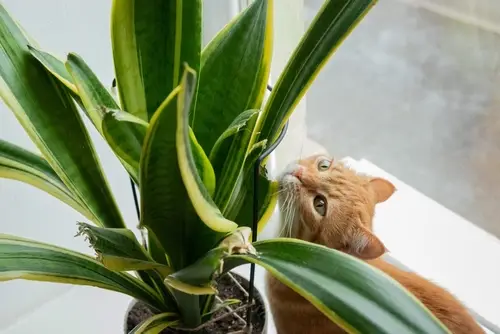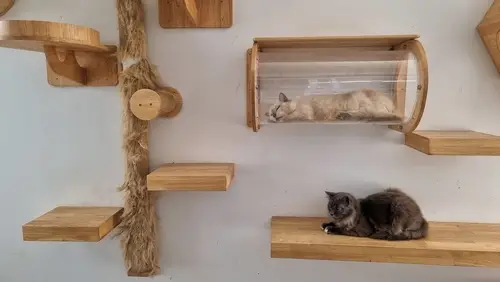Updated on 08/05/25

Mr. Handyman offers expert tips to cat-proof your home and keep your feline safe.
|
Welcoming a new cat into your home? Before the zoomies begin, it’s worth taking a moment to cat-proof your space. From dangling cords to leafy houseplants and claw-worthy furniture legs, the average home is full of temptations for curious kitties.
In this guide, Mr. Handyman® walks you through how to cat-proof your house, room by room. We’ll cover the most common risks, expert-approved safety upgrades, and creative ways to make your home more feline-friendly without sacrificing style or function. Whether you’re preparing for a high-energy kitten or adapting for an older rescue, these tips work for houses, condos, and apartments alike.
What to Know Before You Cat-Proof
Before you start hiding cords or installing balcony mesh, it helps to understand what you’re really protecting against. Cats are clever, curious, and constantly on the move — and what looks safe to you might be their new favorite playground.
Here’s what to know before you begin cat-proofing your house:
- Your cat is part explorer, part acrobat. If it dangles, crinkles, climbs, or glows, cats are going for it. Expect to find them in cabinets, behind furniture, and halfway up your curtains.
- Kittens = maximum mischief. Younger cats are quicker and more curious — and haven’t yet learned what’s dangerous. Think of your kitten as a speedy toddler with claws.
- Common household items can be risky. Loose cords, plastic bags, rubber bands, cleaning products, and even houseplants can pose hidden dangers. A few simple swaps can make a big difference.
- Cat-proofing can still look good. Upgrades like modern cord covers, stylish scratchers, and floating perches can keep your home looking great while protecting your cat.
Common Hazards for Indoor Cats — and How to Prevent Them
From chewing cords to climbing into cabinets, cats are naturally curious. While cute to watch in action, that curiosity can turn dangerous if your space isn’t prepped.
Here are the most common indoor hazards for cats and how to cat-proof them with smart, simple fixes.

Dangling Cords and Loose Wires
Cats love to chase and chew, which makes charging cables, blind cords, and power strips irresistible (and risky).
How to cat-proof it:
- Bundle cords using cable wraps or tubing.
- Use wall clips to keep chargers off the floor.
- Switch to cordless window treatments or shorten blinds with cleats.
Toxic Houseplants
Many popular houseplants — including lilies, aloe, and pothos — are toxic to cats if nibbled. And they will nibble.
How to cat-proof it:
- Replace toxic plants with cat-safe alternatives, like spider plants, bamboo, and catnip.
- Place plants on high shelves or use hanging pots that keep leaves out of reach.
- Keep a list of pet-safe greenery handy when shopping.
Plastic Bags, Rubber Bands, and Hair Ties
Common household items, such as plastic bags and small accessories, present choking hazards for cats.
How to cat-proof it:
- Use covered trash cans or pull-out drawers in kitchens and bathrooms.
- Store hair ties and rubber bands in secure containers.
- Avoid leaving snacks or groceries unattended in bags.
Unscreened Windows or Balconies
Cats are great climbers, but not always great at calculating danger. An open window or balcony is a real risk.
How to cat-proof it:
- Make sure all window screens are sturdy and secure. Remember, cats can jump higher than you think!
- Install balcony mesh or netting if you’re in an apartment or multi-story home.
- Use baby gates or temporary barriers to block stair railings.
Need help securing high-up windows, balcony mesh, or cable management? Our service pros can handle the fixes so your feline stays safe — and your home stays stylish.
Cat-Proofing Room by Room
Every space in your home presents different challenges for a curious cat. From tangled cords to tempting houseplants, here’s how to cat-proof your home one room at a time — without losing your sanity (or your favorite vase).
Living Room
Loose cords and blind strings look like toys. Tuck away power cords or use cord covers, and consider swapping out long blinds for cordless versions or using safety cleats.
Unsecured décor creates a crash zone. Anchor picture frames, lamps, and vases with museum putty or adhesive strips. If it wobbles, it’s fair game.
Candles and essential oils can be dangerous. Skip the open flames and go with flameless candles or diffusers made with cat-safe ingredients.

Kitchen and Dining Area
Cats love counters — but not everything up there is safe. Keep hot surfaces, sharp objects, and food scraps off the counter. Try motion-sensor mats as gentle deterrents.
Small items = big choking hazards. Rubber bands, twist ties, and packaging bits belong in drawers, not on surfaces.
Trash can raids are common. Use a bin with a locking lid or tuck your trash under the sink to stop midnight snack missions.
Bedroom, Office, and Laundry
Jewelry, cords, and hair ties are irresistible. Use storage trays and cable wraps to keep shiny or stringy things out of sight.
Closets are cozy and tempting. Keep closet doors closed unless you want your sweaters turned into nap pads.
Bathroom
Toilets aren’t water bowls. Always keep the lid down, especially with small cats or kittens in the home.
Toxic cleaners and medications are within paw's reach. Add childproof latches to bathroom cabinets and never leave products on open counters.
Floss, Q-tips, and cotton balls are cat bait. Keep them off the counter and stored in closed containers to avoid accidental ingestion.
Cat-Safe Design Ideas That Work
A truly cat-proof house isn’t just about hiding cords — it’s about designing spaces that satisfy your cat’s natural instincts. Here’s how to keep your curious cat active, engaged, and safe with clever upgrades that blend seamlessly into your home.
Vertical Space: Give Your Cat a Room with a View
Cats are climbers by nature. Adding vertical territory gives them space to play, perch, and relax, without claiming your countertops.
Install cat wall shelves, tall towers, or window perches that double as birdwatching lounges. These additions not only protect your furniture, they also help reduce stress and destructive behavior.
Scratching Stations: Save Your Sofa, Support Their Instincts
Scratching helps cats stretch, mark territory, and keep their claws healthy, but they need a designated spot to do it.
Secure wall scratchers near their favorite lounging areas, or place vertical and horizontal pads around high-traffic zones. Look for styles that match your décor so your home stays as beautiful as it is functional.

Toys and Enrichment: Keep Cats Busy (and Out of Trouble)
When cats get bored, they get creative — and that’s when your plants, blinds, or headphones become their next target.
Rotate toys weekly to keep them novel. Try interactive feeders, climbing tunnels, or DIY cardboard forts. A few thoughtfully placed distractions can save you from a lot of chaos.
Cat-Proofing an Apartment or Small Space
Living in a small home or apartment doesn’t mean your cat-proofing efforts have to be limited — it just means you have to get a little more creative.
In compact spaces, there’s less room for error and fewer places to hide hazards, so every square foot counts.

Here’s how to cat-proof an apartment:
Think Vertical
In smaller homes, wall space is gold. Cat shelves, mounted perches, and window hammocks give your feline friend a secure place to climb, perch, and people-watch — without taking up precious floor space. Bonus: Vertical setups reduce feline boredom and keep your furniture scratch-free.
Pick Smart Furniture
Multi-functional furniture can go a long way. Think ottomans with storage, side tables that double as hideaways, or benches with built-in cubbies. These pieces help you stay organized while giving your cat quiet places to nap or observe.
Control Access
Use baby gates, screen barriers, or door blockers to keep cats out of areas like kitchens or balconies. These simple fixes help establish boundaries and prevent accidents from day one.
Declutter the Dangers
Small homes often mean more shared surfaces, so make sure yours are cat-safe. Store hair ties, rubber bands, cords, and breakables in drawers or containers. If it jingles, dangles, or crinkles, cats can’t resist investigating.
Need Help Cat-Proofing Your Home? Mr. Handyman Is Here for You
Cat-proofing your house is more than a checklist — it’s about creating a space where your feline friend can explore safely, without risking your peace of mind (or your furniture).
Whether you need help anchoring shelves, sealing off balconies, or installing pet-friendly upgrades, Mr. Handyman makes it easy to get the job done right.
Our experienced service professionals arrive on time, prepare thoroughly, and treat your home with respect. Every service is backed by the Neighborly Done Right Promise®, so you can feel confident in every scratch pad, shelf, and safety feature we install.
Ready to create a cat-friendly space that works for everyone? Contact your local Mr. Handyman today to schedule your cat-proofing project.
This article is intended for general informational purposes only and may not be applicable to every situation. You are responsible for determining the proper course of action for your home and property. Mr. Handyman is not responsible for any damages that occur as a result of this blog content or your actions. For the most accurate guidance, contact your local Mr. Handyman location for a comprehensive, on-site assessment.
FAQs About How to Cat-Proof Your House
Mr. Handyman has been helping homeowners and businesses repair, maintain, and enhance their spaces for over 25 years! We are the one-stop solution for everything on your to-do list. This includes answering your questions about home repairs, maintenance, and improvements. Here are answers to some of your most frequently asked questions on how to cat-proof your house.
How do I cat-proof an apartment without damaging anything?
If you’re renting an apartment, focus your cat-proofing strategy on non-permanent fixes that won’t damage walls, such as cord covers, tension-mounted shelves, or balcony mesh. A home improvement professional can install renter-friendly solutions to keep your cat safe and protect your security deposit.
Can I cat-proof a balcony if I live in a rental?
Yes — balcony mesh is a safe, removable way to cat-proof a balcony. A home improvement professional can install mesh barriers that won’t damage your railing or walls, so you can protect your cat without losing your deposit.
How long does it take to cat-proof a home?
Most cat-proofing typically takes 2–4 hours, depending on the size of your home and the extent of the upgrades. From securing cords to anchoring shelves, our service pros handle it quickly so your cat can explore safely.
What household items are most dangerous to cats?
Plastic bags, rubber bands, dangling cords, toxic plants, and unsecured windows are common hazards for cats. Cat-proofing swaps these for safer options like cord wraps, pet-safe greenery, and screen protection.
What’s the best way to stop a cat from chewing cords?
To prevent cats from chewing on cords, try wrapping cords with tubing, using adhesive clips to keep them off the floor and against the wall, and offer chew toys as a safer alternative. A professional handyman can install long-term solutions that hide cables completely.
Is cat-proofing worth it?
Absolutely. Cat-proofing helps prevent injuries, protect furniture, and keep your home safer and cleaner while allowing your cat to engage its natural instincts in a non-destructive way. It’s especially important for new kittens or rescue cats adjusting to a new environment.
Can I still cat-proof my home if I live in a small space?
Yes! Use wall-mounted perches to create vertical space and multi-purpose furniture (like cubby benches or hideaway ottomans) to maximize the usable living area for yourself and your cat. A handyman professional can install custom solutions to fit any layout — no square footage wasted.
